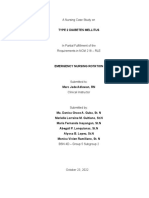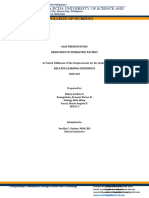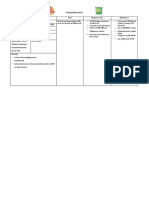A Case of Hypertension in Diabetes This Case Study Aims To
A Case of Hypertension in Diabetes This Case Study Aims To
Uploaded by
walit1101 mukrininCopyright:
Available Formats
A Case of Hypertension in Diabetes This Case Study Aims To
A Case of Hypertension in Diabetes This Case Study Aims To
Uploaded by
walit1101 mukrininOriginal Description:
Original Title
Copyright
Available Formats
Share this document
Did you find this document useful?
Is this content inappropriate?
Copyright:
Available Formats
A Case of Hypertension in Diabetes This Case Study Aims To
A Case of Hypertension in Diabetes This Case Study Aims To
Uploaded by
walit1101 mukrininCopyright:
Available Formats
Case Study
A CASE OF HYPERTENSION IN DIABETES
This case study aims to
• Help understand the association between hypertension and type 2 diabetes mellitus.
• State the goals for treatment of hypertension in patients with diabetes mellitus
• Discuss the choice of antihypertensives in hypertensive patients with diabetes.
• List the various antihypertensives their mechanisms of action
• Describe the routine primary management for a patient with type 2 diabetes.
History
Mr. G is a 45-year-old gentleman with a history of type 2 diabetes, obesity, and hypertension.
The patient was diagnosed with type 2 diabetes 7 years ago when during an insurance
examination. Mr. G. is 172 cms and has always been over weight, with his weight fluctuating
between 85 and 90 kg.
Initial treatment for his diabetes consisted of a Tab glimepiride 1 mg/day with metformin. His
diabetes has been under fair control with a most recent hemoglobin A1c of 7.4%.
Hypertension was diagnosed about 5 years ago when blood pressure (BP) measured in the
family physician’s clinic was noted to be consistently elevated in the range of 160/90 mmHg
on three occasions. Mr.G. was initially treated with ramipril, starting at 5 mg daily and
increasing to 10 mg daily, yet his BP control has fluctuated.
One year ago, microalbuminuria was detected on an annual urine screen, with 2010 mg/dl of
microalbumin identified on a spot urine sample.
Mr. G. comes for his usual follow-up visit for diabetes. Physical examination reveals an a BP
of 150/90 mmHg and a pulse of 80 bpm
1. What is the relationship between hypertension and diabetes?
Hypertension is more common in diabetics than non-diabetics. Hypertension is a major factor
in development of macro vascular and micro vascular complications in a diabetic patient.
The patient is at a greater risk of developing cardiovascular complications. Isolated systolic
hypertension is more common in diabetics than non diabetics and is a risk factor for macro
vascular disease
Diabetes mellitus is a major risk factor for cardiovascular disease (CVD). Approximately
two-thirds of people with diabetes die from complications of CVD. Patients with diabetes are
prone to a number of cardiovascular risk factors beyond hyperglycemia. These risk factors,
including hypertension, dyslipidemia, and a sedentary lifestyle, are particularly prevalent
among patients with diabetes. To reduce the mortality and morbidity from CVD among
patients with diabetes, aggressive treatment of glycemic control as well as other
cardiovascular risk factors must be initiated.
2. Target BP for patients with diabetes and hypertension is
a) < 130/89 mm Hg
b) < 140/90 mm Hg
c) < 150/100 mm Hg
d) Neither of the above
The correct answer is a < 130/80 mm Hg
Blood pressure should be measured at every routine diabetes visit. Patients found to have
systolic blood pressure ≥130 mmHg or diastolic blood pressure ≥80 mmHg should have
blood pressure confirmed on a separate day. Repeat systolic blood pressure ≥130 mmHg or
diastolic blood pressure ≥80 mmHg confirms a diagnosis of hypertension
The United Kingdom Prospective Diabetes Study (UKPDS), which followed patients with
diabetes for an average of 8.5 years, found that patients with tight BP control (< 150/< 85
mmHg) versus less tight control (< 180/< 105 mmHg) had lower rates of myocardial
infarction (MI), stroke, and peripheral vascular events. In the UKPDS, each 10-mmHg
decrease in mean systolic BP was associated with a 12% reduction in risk for any
complication related to diabetes, a 15% reduction for death related to diabetes, and an 11%
reduction for MI.
The Hypertension Optimal Treatment (HOT) trial has shown that patients assigned to lower
BP targets have improved outcomes. In the HOT trial, patients who achieved a diastolic BP
of < 80 mmHg benefited the most in terms of reduction of cardiovascular events. Other
epidemiological studies have shown that BPs > 120/70 mmHg are associated with increased
cardiovascular morbidity and mortality in people with diabetes. The American Diabetes
Association has recommended a target BP goal of < 130/80 mmHg
3. The antihypertensive agents recommended for patients with diabetes are
a) ACE inhibitors
b) ARBS
c) Both of the above
d) Neither of the above
The correct answer is c- both ACEIs and ARBs
Patients with a systolic blood pressure of 130–139 mmHg or a diastolic blood
pressure of 80–89 mmHg may be given lifestyle therapy alone for a maximum of 3
months and then, if targets are not achieved, treated with addition of pharmacological
agents
Patients with more severe hypertension (systolic blood pressure ≥140 or diastolic
blood pressure ≥90 mmHg) at diagnosis or follow-up should receive pharmacologic
therapy in addition to lifestyle therapy
Pharmacologic therapy for patients with diabetes and hypertension should be with a
regimen that includes either an ACE inhibitor or an angiotensin receptor blocker
(ARB). If one class is not tolerated, the other should be substituted. If needed to
achieve blood pressure targets, a thiazide diuretic should be added to those with an
estimated glomerular filtration rate (GFR) (see below) ≥30 ml/min per 1.73 m2 and a
loop diuretic for those with an estimated GFR <30 ml/min per 1.73 m2
Multiple drug therapy (two or more agents at maximal doses) is generally required to
achieve blood pressure targets
If ACE inhibitors, ARBs, or diuretics are used, kidney function and serum potassium
levels should be closely monitored
In pregnant patients with diabetes and chronic hypertension, blood pressure target
goals of 110–129/65–79 mmHg are suggested in the interest of long-term maternal
health and minimizing impaired fetal growth. ACE inhibitors and ARBs are
contraindicated during pregnancy
The UKPDS showed no significant differences in outcomes for treatment for
hypertension using an ACE inhibitor or a β-blocker. In addition, both ACE inhibitors and
angiotensin II receptor blockers (ARBs) have been shown to slow the development and
progression of diabetic nephropathy.
In the Heart Outcomes Prevention Evaluation (HOPE) trial, ACE inhibitors were found to
have a favorable effect in reducing cardiovascular morbidity and mortality, whereas
recent trials have shown a renal protective benefit from both ACE inhibitors and ARBs.
ACE inhibitors and β-blockers seem to be better than dihydropyridine calcium-channel
blockers to reduce MI and heart failure. However, trials using dihydropyridine calcium-
channel blockers in combination with ACE inhibitors and β-blockers do not appear to
show any increased morbidity or mortality in CVD, as has been implicated in the past for
dihydropyridine calcium-channel blockers alone.
The Antihypertensive and Lipid-Lowering Treatment to Prevent Heart Attack Trial
(ALLHAT) in high-risk hypertensive patients, including those with diabetes,
demonstrated that chlorthalidone, a thiazide-type diuretic, was superior to an ACE
inhibitor, lisinopril, in preventing one or more forms of CVD.
4. What are the various antihypertensives used in diabetics
________________________________________________________________________
Drug, daily dosage Recommended in Avoid in Side effects
Calcium channel Asthmatics, patients Heart blocks Flushing,
blockers with concomitant (verapamil and headaches, ankle
Nifedipine 15-60mg angina (except diltiazem oedema, gum
Amlodipine 5-10mg nifedipine), PVD, hyperplasia
Felodipine 5-20 mg
Nitrendipine 5-40mg
ACE inhibitors CHF, LVH Renal artery Cough,
Captopril 25-150mg, stenosis, angioneurotic
Enalapril 2.5-15 mg, pregnancy, use oedema
Lisinopril 5 –30 mg, with caution in
Ramipril 1.25-10 mg patients with CRF,
Perindopril 4-8 mg and with diuretics
ARBs CHF, LVH Renal artery
Losartan K 25-100 stenosis,
mg/day pregnancy, use
Valsartan 80-160 with caution in
mg/day patients with CRF,
Olmesartan 20-40 and with diuretics
mg/day
Telmisartan 20-80
mg/day
Alpha blockers Asthmatics, PVD, Severe aortic Headache, dry
Prazosin 1-5 mg prostatic symptoms, stenosis mouth, first dose
Terazosin1-20 mg impotence, syncope
hyperlipidemias
Case contd.
Hydrochlorthiazide 12.5 mg/day was added o the treatment regimen,
The blood pressure dropped to 130 m/84 mm of Hg over aperiod of 2 weeks
Take home messages.
1. Hypertension is a risk factor for cardiovascular complications of diabetes.
2. Clinical trials demonstrate that drug therapy versus placebo will reduce cardiovascular
events when treating patients with hypertension and diabetes.
3. A target BP goal of < 130/80 mmHg is recommended.
4. Pharmacological therapy needs to be individualized to fit patients' needs.
5. ACE inhibitors, ARBs, diuretics, and β-blockers have all been documented to be
effective pharmacological treatment.
6. Combinations of drugs are often necessary to achieve target levels of BP control.
7. ACE inhibitors and ARBs are agents best suited to retard progression of nephropathy.
References
1) ALLHAT Officers and Coordinators for the ALLHAT Collaborative Research Group:
Major outcomes in high-risk hypertensive patients randomized to angiotensin-
converting enzyme inhibitor or calcium channel-blocker vs. diuretic: the
Antihypertensive and Lipid-Lowering Treatment to Prevent Heart Attack Trial.
JAMA288 : 2981-2997,2002
2) American Diabetes Association: Hypertension management in adults with diabetes
(Position Statement). Diabetes Care 27 (Suppl. 1):S65 -S67, 2004
3) Hansson L, Zanchetti A, Carruthers SG, Dahlof B, Elmfeldt D, Julius S, Menard J,
Rahn KH, Wedel H, Westerling S: Effects of intensive blood pressure lowering and
low dose aspirin in patients with hypertension: principal results of the Hypertension
Optimal Treatment (HOT) randomized trial. Lancet 351:1755 -1762, 1998
4) U.K. Prospective Diabetes Study Group: Efficacy of atenolol and captopril in
reducing risk of macrovascular and microvascular complications in type 2 diabetes
(UKPDS 39). BMJ 317:713 -720, 1998
You might also like
- Pat 2 Medsurg1Document20 pagesPat 2 Medsurg1api-300849832No ratings yet
- MedSurg Notes - Cancer of The LiverDocument2 pagesMedSurg Notes - Cancer of The LiverMae CeaesarNo ratings yet
- CASE STUDY (Gastro)Document3 pagesCASE STUDY (Gastro)Jake Yvan DizonNo ratings yet
- USMLE Road Map ImmunologyDocument242 pagesUSMLE Road Map ImmunologyFernanda Granillo100% (10)
- GE BasavaDocument21 pagesGE BasavaAmalin PrãdhãñNo ratings yet
- CASE STUDY TablesDocument9 pagesCASE STUDY TablesMicah MagallanoNo ratings yet
- MI Case Study FinalDocument25 pagesMI Case Study FinalAlmaNo ratings yet
- Caso Clínico de DislipidemiaDocument3 pagesCaso Clínico de DislipidemiaCamiiliita Fernández La TorreNo ratings yet
- Case Study HypertensionDocument27 pagesCase Study HypertensionEvora, Sichem D.No ratings yet
- Nursing Care Process Case StudyDocument6 pagesNursing Care Process Case StudyEunice RosalesNo ratings yet
- Case Presentation CKDDocument35 pagesCase Presentation CKDKojo EgyirNo ratings yet
- Case 7 ResultsDocument14 pagesCase 7 ResultsRegia putri ellandaNo ratings yet
- Case Presentation On LrtiDocument17 pagesCase Presentation On LrtiNewtan DebNo ratings yet
- Tagum Doctors College, IncDocument2 pagesTagum Doctors College, IncJIMENEZ, TRISHA MARIE D.No ratings yet
- Acute Tonsil Lo PharyngitisDocument27 pagesAcute Tonsil Lo PharyngitisCheysser Alagao50% (2)
- Environmental and Nutritional DiseasesDocument44 pagesEnvironmental and Nutritional DiseasesAppas Saha100% (1)
- CKD Case PresentationDocument64 pagesCKD Case PresentationGenevieve MundalaNo ratings yet
- Genetics and Hypertension (2015)Document66 pagesGenetics and Hypertension (2015)Verry HidayatNo ratings yet
- Peds Case 3Document5 pagesPeds Case 3Mohammed AhmedNo ratings yet
- AKI CASE NishaDocument64 pagesAKI CASE NishaSurkhali Bipana100% (1)
- Case 6: Delos Reyes, Lasac, Majid, Mamangun, YuDocument49 pagesCase 6: Delos Reyes, Lasac, Majid, Mamangun, YuAbdullah Bin MajidNo ratings yet
- A Case Study On AsthmaDocument38 pagesA Case Study On AsthmaMark Tristan AsuncionNo ratings yet
- BSN4D-SG2 DM Type2Document201 pagesBSN4D-SG2 DM Type2Charisse CaydanNo ratings yet
- Eclampsia PresentationDocument6 pagesEclampsia Presentationshakuntla DeviNo ratings yet
- Drug-Study-Ncp-And-Fdar - Sir WencyDocument21 pagesDrug-Study-Ncp-And-Fdar - Sir WencyBiway RegalaNo ratings yet
- Case PresentationDocument20 pagesCase PresentationMohamad HafyfyNo ratings yet
- Case Press FinalDocument32 pagesCase Press FinalmadsoleNo ratings yet
- Hypertension in OBSTETRICDocument24 pagesHypertension in OBSTETRICTarana NadeemNo ratings yet
- Interview QuestionsDocument4 pagesInterview QuestionsJilian McGuganNo ratings yet
- Diabetes Mellitus in PediatricsDocument22 pagesDiabetes Mellitus in PediatricsKermaigne MirandaNo ratings yet
- Case Study On Ibd17Document2 pagesCase Study On Ibd17api-381128376No ratings yet
- IM AdconDocument28 pagesIM AdconCla SantosNo ratings yet
- Case Study On Acute Gastritis: T Villanueva Avenue, Naga CityDocument26 pagesCase Study On Acute Gastritis: T Villanueva Avenue, Naga CityMark Jefferson LunaNo ratings yet
- Case Presentation On Chronic Kidney Disease1Document18 pagesCase Presentation On Chronic Kidney Disease1d100% (1)
- Client Profile With HypertensionDocument8 pagesClient Profile With HypertensionplokatzNo ratings yet
- Case Scenario Osteoarthritis Week 16 GerontologDocument5 pagesCase Scenario Osteoarthritis Week 16 GerontologMary Josette NavarraNo ratings yet
- Case Presentation On Copd: By, Thomas Eipe Pharm D InternDocument32 pagesCase Presentation On Copd: By, Thomas Eipe Pharm D InternThomas EipeNo ratings yet
- Case Study Icu Sem 6Document30 pagesCase Study Icu Sem 6BM2-0619 Mohd Khairul Naaim Bin PenchariNo ratings yet
- Diabetes Mellitus - Diabetic KetoacidosisDocument21 pagesDiabetes Mellitus - Diabetic KetoacidosisJamil Lorca100% (5)
- Propranolol 1 PresentationDocument17 pagesPropranolol 1 Presentationapi-284092317100% (1)
- Elderly Nursing Case StudyDocument12 pagesElderly Nursing Case StudyCherique Rico0% (1)
- Toaz - Info Case Study Pneumonia PRDocument41 pagesToaz - Info Case Study Pneumonia PRTrixNo ratings yet
- Case Study OsteoporosisDocument17 pagesCase Study Osteoporosistarikeops50% (2)
- Nursing Care PlanDocument16 pagesNursing Care PlanMelody B. MiguelNo ratings yet
- Case Report Non-infection Unit Β-Major ThalassemiaDocument27 pagesCase Report Non-infection Unit Β-Major ThalassemiaimamkdNo ratings yet
- Cerebrovascular Disease (Bleed)Document25 pagesCerebrovascular Disease (Bleed)Margaret Jenaw JenawNo ratings yet
- Case Presentation IM DDHDocument12 pagesCase Presentation IM DDHAishwarya BharathNo ratings yet
- Drug Study Pyrantel & CefuroximeDocument2 pagesDrug Study Pyrantel & CefuroximeMikhael Briones ApasNo ratings yet
- Nursing Care Plan HYPERTENSIONDocument3 pagesNursing Care Plan HYPERTENSIONJasmin T. RegaspiNo ratings yet
- BRONCHITIS Case PresentationDocument28 pagesBRONCHITIS Case PresentationJoshua DulayNo ratings yet
- 1 Endorsement NotesDocument2 pages1 Endorsement NotesLorraine GambitoNo ratings yet
- I Patient Assessment Data BaseDocument12 pagesI Patient Assessment Data BaseJanice_Fernand_1603No ratings yet
- Case Presentation On MalariaDocument13 pagesCase Presentation On Malarialavate amol bhimraoNo ratings yet
- CASE STUDY #2 Digestive System (Acute Pancreatitis)Document3 pagesCASE STUDY #2 Digestive System (Acute Pancreatitis)Lerma PagcaliwanganNo ratings yet
- Dysmenorrhea Definition PDFDocument14 pagesDysmenorrhea Definition PDFYogi HermawanNo ratings yet
- Modified CaseDocument22 pagesModified CaseAli HawamdeNo ratings yet
- Ventricular Septal Defect, A Simple Guide To The Condition, Treatment And Related ConditionsFrom EverandVentricular Septal Defect, A Simple Guide To The Condition, Treatment And Related ConditionsNo ratings yet
- Cyanosis, A Simple Guide To The Condition, Diagnosis, Treatment And Related ConditionsFrom EverandCyanosis, A Simple Guide To The Condition, Diagnosis, Treatment And Related ConditionsRating: 5 out of 5 stars5/5 (1)
- Role of Dietary Fibers and Nutraceuticals in Preventing DiseasesFrom EverandRole of Dietary Fibers and Nutraceuticals in Preventing DiseasesRating: 5 out of 5 stars5/5 (1)
- KetorolacDocument8 pagesKetorolacwalit1101 mukrininNo ratings yet
- Patient and Physician Satisfaction With A Pharmacist-Managed Anticoagulation Clinic: Implications For Managed Care OrganizationsDocument4 pagesPatient and Physician Satisfaction With A Pharmacist-Managed Anticoagulation Clinic: Implications For Managed Care Organizationswalit1101 mukrininNo ratings yet
- Review JurnalDocument4 pagesReview Jurnalwalit1101 mukrininNo ratings yet
- Lafi AdDocument81 pagesLafi Adwalit1101 mukrininNo ratings yet
- CBSE Question Paper 2018 Class 12 Physical Education (Theory) (Reconducted)Document2 pagesCBSE Question Paper 2018 Class 12 Physical Education (Theory) (Reconducted)GuguBoiNo ratings yet
- Janapadodhwamsa: DR - Sangita Maharjan BAMS, MD (Roga Nidana)Document19 pagesJanapadodhwamsa: DR - Sangita Maharjan BAMS, MD (Roga Nidana)Abiskar AdhikariNo ratings yet
- Medical and Applied SciencesDocument2 pagesMedical and Applied Sciencesapi-422810721No ratings yet
- Adie's Pupil in The Ross Syndrome: Images in Clinical MedicineDocument1 pageAdie's Pupil in The Ross Syndrome: Images in Clinical MedicineOlvaria MisfaNo ratings yet
- Care Sheet - Asian Leaf Turtle (Cyclemys Dentata)Document3 pagesCare Sheet - Asian Leaf Turtle (Cyclemys Dentata)John GamesbyNo ratings yet
- Scope of Nursing ResearchDocument16 pagesScope of Nursing Researchvincy100% (6)
- Mekant: User ManualDocument120 pagesMekant: User ManualAagam ShahNo ratings yet
- Hamilton Anxiety Rating Scale IntroductionDocument10 pagesHamilton Anxiety Rating Scale Introductionxijipe1553No ratings yet
- Nephrology Notes For USMLEDocument2 pagesNephrology Notes For USMLEGrilled Crowe100% (1)
- Endocrine Control - Slide Show - Roderick LaneDocument150 pagesEndocrine Control - Slide Show - Roderick LanedimiourgontasNo ratings yet
- Nursing Care of Client With HypospadiaDocument21 pagesNursing Care of Client With HypospadiaancoursNo ratings yet
- TURP (Hailand and Padilla)Document2 pagesTURP (Hailand and Padilla)Nicole PadillaNo ratings yet
- Merrill 2017Document18 pagesMerrill 2017Duy PhạmNo ratings yet
- Mandibular FracturesDocument67 pagesMandibular FracturesAbel AbrahamNo ratings yet
- Chola MS PreAuth FormDocument5 pagesChola MS PreAuth FormvijayclaimbuddyNo ratings yet
- Ngeh 2006Document5 pagesNgeh 2006ayu fitriaNo ratings yet
- Mapeh-Health: Quarter 1 - Module 4Document21 pagesMapeh-Health: Quarter 1 - Module 4Noel Angelo MacawayNo ratings yet
- Medical Physics Course Notes (Greg Pitt)Document92 pagesMedical Physics Course Notes (Greg Pitt)Mel ClancyNo ratings yet
- Journal Impact FactorDocument376 pagesJournal Impact Factorsenthilkumarm50No ratings yet
- ANNEX F (Page 1of 3)Document12 pagesANNEX F (Page 1of 3)elmersgluethebombNo ratings yet
- Denistya Amalia - Task and Answer Task 3.3 Writing Nursing DiagnosisDocument2 pagesDenistya Amalia - Task and Answer Task 3.3 Writing Nursing DiagnosisNazimatul FitriyahNo ratings yet
- Hepatobiliary Pancreatic Radiology 1683072599120Document31 pagesHepatobiliary Pancreatic Radiology 1683072599120Shivank RastogiNo ratings yet
- Soal PAS BIG Xi, SMT 3, OnlineDocument10 pagesSoal PAS BIG Xi, SMT 3, OnlineRivaldi Lukman HakimNo ratings yet
- Genetics and Biotechnology Reaction PaperDocument2 pagesGenetics and Biotechnology Reaction PaperARLENE POMBONo ratings yet
- W3-19 Operative Obstetrics - LectureDocument72 pagesW3-19 Operative Obstetrics - LectureRanjit SharmaNo ratings yet
- MCS 2011 OTC Medication GuideDocument14 pagesMCS 2011 OTC Medication GuideDavid Hosam100% (1)
- Science 9 Q1 Module-3 For PrintingDocument31 pagesScience 9 Q1 Module-3 For PrintingRica Abigail DagosNo ratings yet
- +lymphoedema 150118110815 Conversion Gate02Document24 pages+lymphoedema 150118110815 Conversion Gate02Oussama ANo ratings yet
- Depression and Mental Wellbeing in People Affected by Leprosy in Southern NepalDocument9 pagesDepression and Mental Wellbeing in People Affected by Leprosy in Southern NepalMedNo ratings yet





























































































